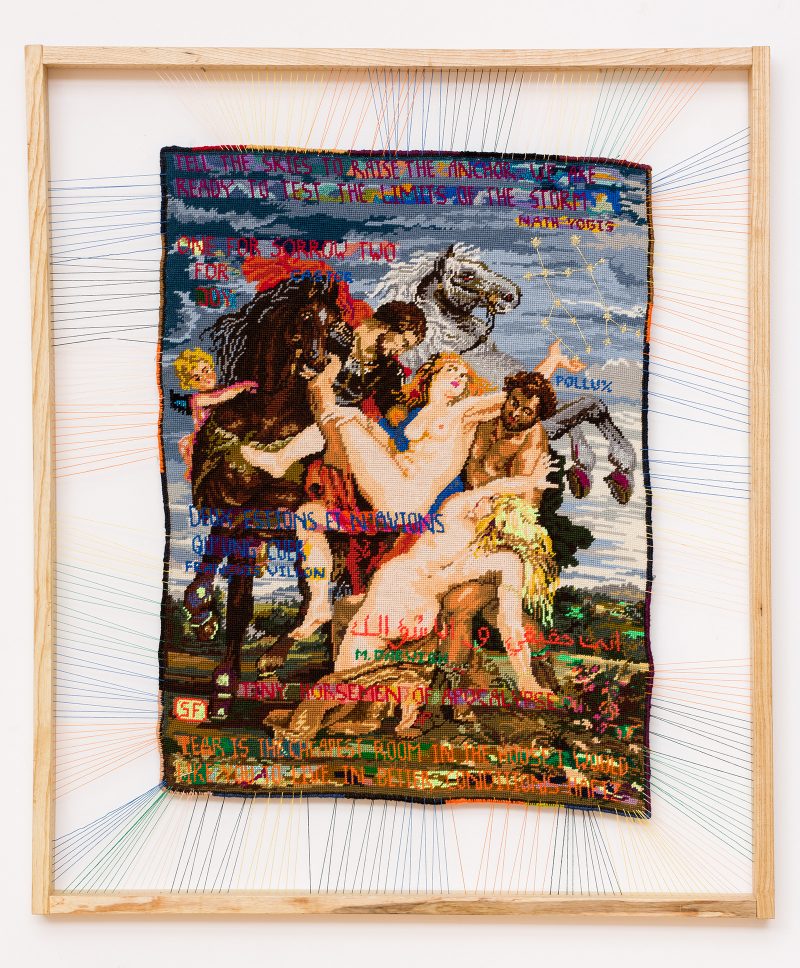
Sylvie Franquet’s reMembering is nothing less than a treatise on how art history has plundered the female form and women’s idle hands. Franquet’s intimate, reconfigured tapestries now on view at London’s October Gallery recall my own mother’s needlepoints of tulips and roses, little girls and blue skies–laborious forays into home decoration. Well made, but uninteresting–a condescending opinion of mine, I admit, that haunts me today. Indeed, I once asked my mother to produce a pair of text works; she acquiesced, but grudgingly, complaining, “I don’t like your conceptual works! How about a nice flower!”
Women’s work
Franquet’s conceptual works, however, go one better–repurposing found needlepoint pieces initially cast as homespun souvenir kitsch. These were needlepoint takes on old master paintings that, in the hands of women, became decoration, craft, quaint old time “pixelated” copies. In Franquet’s deft hands, however, they are completely transformed into something else entirely.
The Belgium-born artist, with degrees in Arabic and Islamic culture, has long worked in variations of collage, and for years immersed herself in the economics of female production methods and trades–namely, working with cloth, wool and thread. Franquet, like many female artists (Annette Messager, Tracey Emin, Janine Antoni, and even to some extent Cindy Sherman), has aimed squarely at the history of the art image to explore and properly explode the hegemony of male-derived, “man-made” content in the art world. Layers of texts and collaged additions in this series keep the eye moving and the mind rereading the familiar.
The limits of myth
“Hitched to the Stars” (2014), pictured here, takes the violent “Abduction of the Daughters of Leucippus,” the 1616 masterwork by Peter Paul Rubens, and flips that myth on its back. Franquet suggests ironically we should have a soft reminder of the olden days when those daughters were brutally taken and raped by the twin sons of gods and men.
The artist sews into the needlepoint this text by Hafiz: “Fear is the cheapest room in the house, I would like to see you live in better conditions.” Since Franquet demands that we check out her authors, we did: “Hafiz was a Persian poet who lauded the joys of love and wine but also targeted religious hypocrisy.” The strangely familiar image is easy on the eyes, but ultimately provokes. It is indeed about rape. The experience of looking and thinking about the things we already know–indeed, the myths that have long surrounded us and we embrace–are truly not what they seem. So this artist asks, how and why do we know what we know? In the same piece, another quote: “Tell the Skies to raise the anchor. We are ready to test the limits of the storm.” (Proverb by Nath Yogis). Franquet is asking, is the male monopoly on image culture production finally coming to an end?
In addition to the needlepoint works, Franquet offers a full series of life-sized sewn poupées (puppets or mannequins) that also serve up men and women in sheep’s, emperor’s, and our own clothing–our naked, terribly imperfect selves. Are we–both men and women–able to see through the subtle message proposed here, or do our very senses have to be beaten back and literally raped into consciousness? It is a compelling question and argument if you can see past the pretty flowers.
Sylvie Franquet: reMembering – 1 December 2016 – 28 January 2017 at October Gallery, London. For more about needlepoint, listen to our 2013 podcast interview with Mary Smull talking about her unfinished needlepoint project.








